Evidence Based Practice Assignment 2022
VerifiedAdded on 2022/10/07
|7
|1760
|27
Assignment
AI Summary
Contribute Materials
Your contribution can guide someone’s learning journey. Share your
documents today.
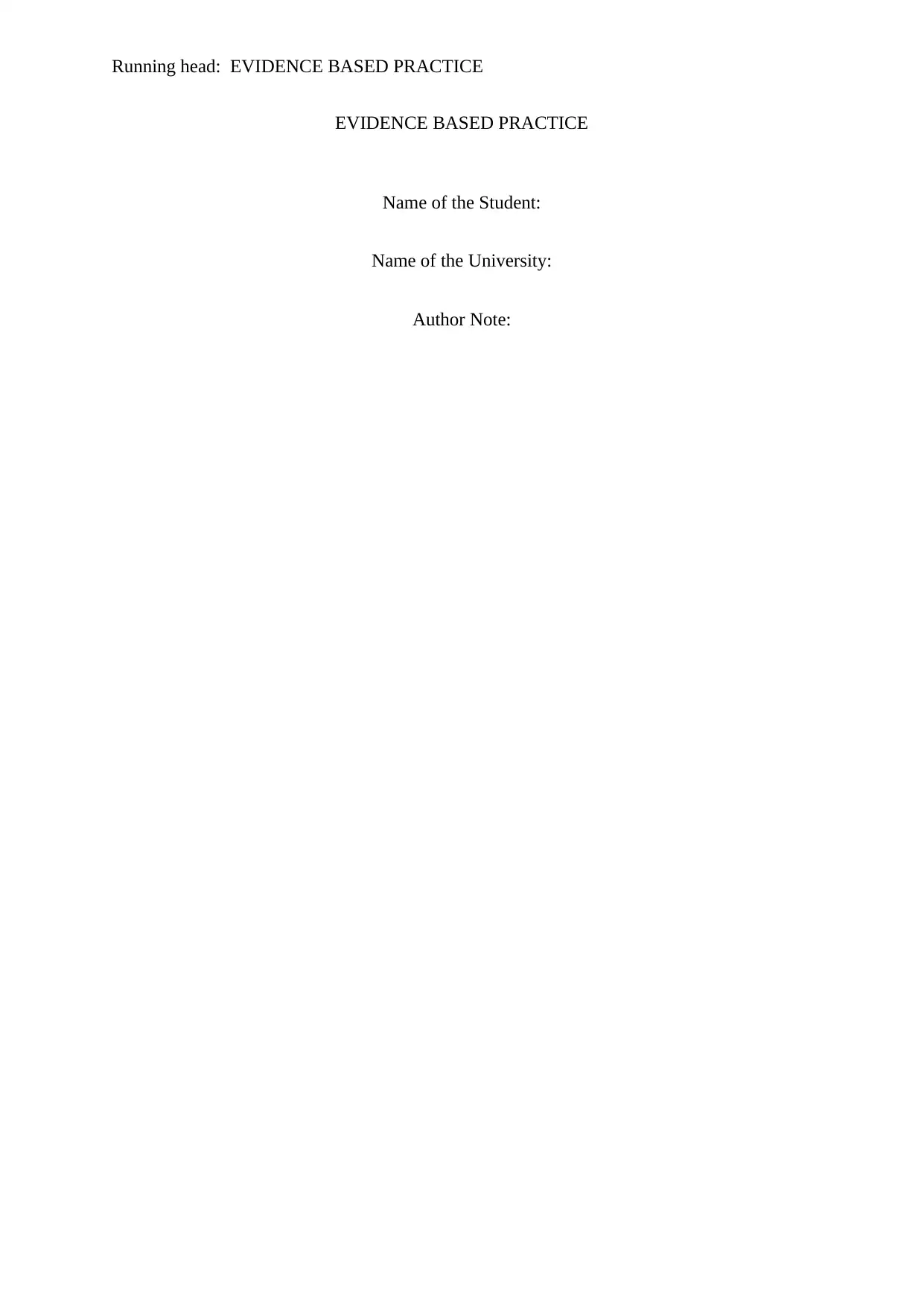
Running head: EVIDENCE BASED PRACTICE
EVIDENCE BASED PRACTICE
Name of the Student:
Name of the University:
Author Note:
EVIDENCE BASED PRACTICE
Name of the Student:
Name of the University:
Author Note:
Secure Best Marks with AI Grader
Need help grading? Try our AI Grader for instant feedback on your assignments.
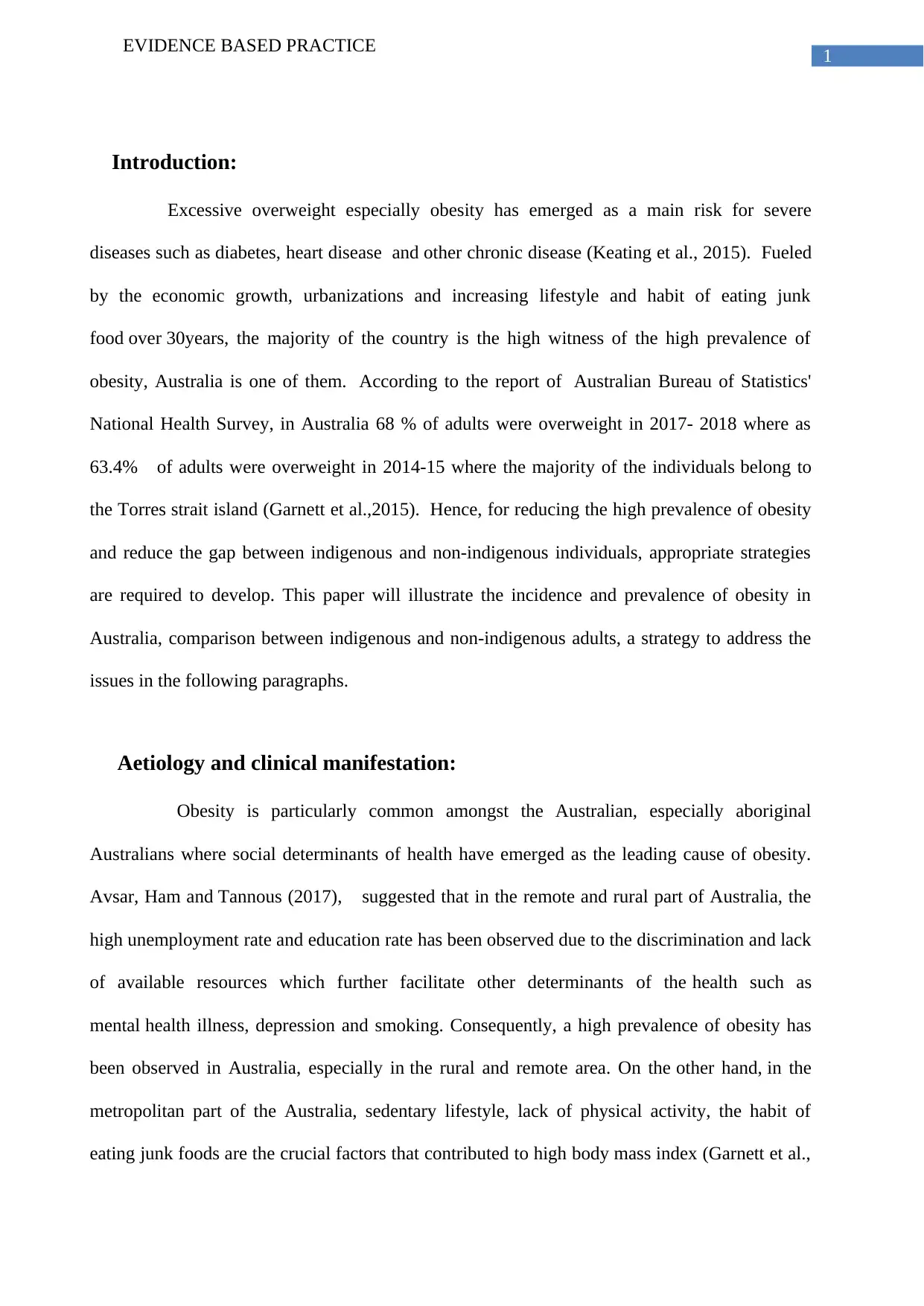
1
EVIDENCE BASED PRACTICE
Introduction:
Excessive overweight especially obesity has emerged as a main risk for severe
diseases such as diabetes, heart disease and other chronic disease (Keating et al., 2015). Fueled
by the economic growth, urbanizations and increasing lifestyle and habit of eating junk
food over 30years, the majority of the country is the high witness of the high prevalence of
obesity, Australia is one of them. According to the report of Australian Bureau of Statistics'
National Health Survey, in Australia 68 % of adults were overweight in 2017- 2018 where as
63.4% of adults were overweight in 2014-15 where the majority of the individuals belong to
the Torres strait island (Garnett et al.,2015). Hence, for reducing the high prevalence of obesity
and reduce the gap between indigenous and non-indigenous individuals, appropriate strategies
are required to develop. This paper will illustrate the incidence and prevalence of obesity in
Australia, comparison between indigenous and non-indigenous adults, a strategy to address the
issues in the following paragraphs.
Aetiology and clinical manifestation:
Obesity is particularly common amongst the Australian, especially aboriginal
Australians where social determinants of health have emerged as the leading cause of obesity.
Avsar, Ham and Tannous (2017), suggested that in the remote and rural part of Australia, the
high unemployment rate and education rate has been observed due to the discrimination and lack
of available resources which further facilitate other determinants of the health such as
mental health illness, depression and smoking. Consequently, a high prevalence of obesity has
been observed in Australia, especially in the rural and remote area. On the other hand, in the
metropolitan part of the Australia, sedentary lifestyle, lack of physical activity, the habit of
eating junk foods are the crucial factors that contributed to high body mass index (Garnett et al.,
EVIDENCE BASED PRACTICE
Introduction:
Excessive overweight especially obesity has emerged as a main risk for severe
diseases such as diabetes, heart disease and other chronic disease (Keating et al., 2015). Fueled
by the economic growth, urbanizations and increasing lifestyle and habit of eating junk
food over 30years, the majority of the country is the high witness of the high prevalence of
obesity, Australia is one of them. According to the report of Australian Bureau of Statistics'
National Health Survey, in Australia 68 % of adults were overweight in 2017- 2018 where as
63.4% of adults were overweight in 2014-15 where the majority of the individuals belong to
the Torres strait island (Garnett et al.,2015). Hence, for reducing the high prevalence of obesity
and reduce the gap between indigenous and non-indigenous individuals, appropriate strategies
are required to develop. This paper will illustrate the incidence and prevalence of obesity in
Australia, comparison between indigenous and non-indigenous adults, a strategy to address the
issues in the following paragraphs.
Aetiology and clinical manifestation:
Obesity is particularly common amongst the Australian, especially aboriginal
Australians where social determinants of health have emerged as the leading cause of obesity.
Avsar, Ham and Tannous (2017), suggested that in the remote and rural part of Australia, the
high unemployment rate and education rate has been observed due to the discrimination and lack
of available resources which further facilitate other determinants of the health such as
mental health illness, depression and smoking. Consequently, a high prevalence of obesity has
been observed in Australia, especially in the rural and remote area. On the other hand, in the
metropolitan part of the Australia, sedentary lifestyle, lack of physical activity, the habit of
eating junk foods are the crucial factors that contributed to high body mass index (Garnett et al.,
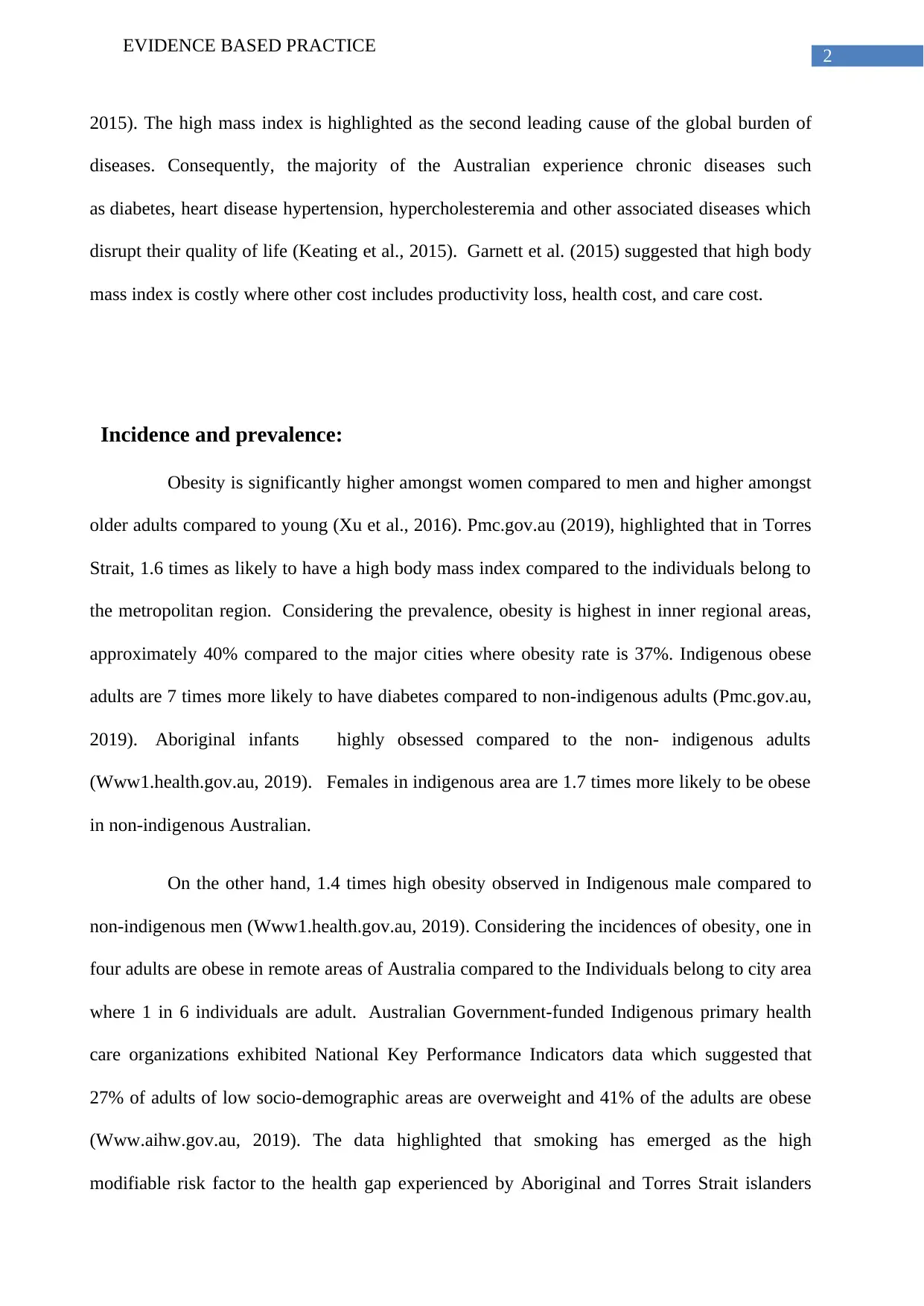
2
EVIDENCE BASED PRACTICE
2015). The high mass index is highlighted as the second leading cause of the global burden of
diseases. Consequently, the majority of the Australian experience chronic diseases such
as diabetes, heart disease hypertension, hypercholesteremia and other associated diseases which
disrupt their quality of life (Keating et al., 2015). Garnett et al. (2015) suggested that high body
mass index is costly where other cost includes productivity loss, health cost, and care cost.
Incidence and prevalence:
Obesity is significantly higher amongst women compared to men and higher amongst
older adults compared to young (Xu et al., 2016). Pmc.gov.au (2019), highlighted that in Torres
Strait, 1.6 times as likely to have a high body mass index compared to the individuals belong to
the metropolitan region. Considering the prevalence, obesity is highest in inner regional areas,
approximately 40% compared to the major cities where obesity rate is 37%. Indigenous obese
adults are 7 times more likely to have diabetes compared to non-indigenous adults (Pmc.gov.au,
2019). Aboriginal infants highly obsessed compared to the non- indigenous adults
(Www1.health.gov.au, 2019). Females in indigenous area are 1.7 times more likely to be obese
in non-indigenous Australian.
On the other hand, 1.4 times high obesity observed in Indigenous male compared to
non-indigenous men (Www1.health.gov.au, 2019). Considering the incidences of obesity, one in
four adults are obese in remote areas of Australia compared to the Individuals belong to city area
where 1 in 6 individuals are adult. Australian Government-funded Indigenous primary health
care organizations exhibited National Key Performance Indicators data which suggested that
27% of adults of low socio-demographic areas are overweight and 41% of the adults are obese
(Www.aihw.gov.au, 2019). The data highlighted that smoking has emerged as the high
modifiable risk factor to the health gap experienced by Aboriginal and Torres Strait islanders
EVIDENCE BASED PRACTICE
2015). The high mass index is highlighted as the second leading cause of the global burden of
diseases. Consequently, the majority of the Australian experience chronic diseases such
as diabetes, heart disease hypertension, hypercholesteremia and other associated diseases which
disrupt their quality of life (Keating et al., 2015). Garnett et al. (2015) suggested that high body
mass index is costly where other cost includes productivity loss, health cost, and care cost.
Incidence and prevalence:
Obesity is significantly higher amongst women compared to men and higher amongst
older adults compared to young (Xu et al., 2016). Pmc.gov.au (2019), highlighted that in Torres
Strait, 1.6 times as likely to have a high body mass index compared to the individuals belong to
the metropolitan region. Considering the prevalence, obesity is highest in inner regional areas,
approximately 40% compared to the major cities where obesity rate is 37%. Indigenous obese
adults are 7 times more likely to have diabetes compared to non-indigenous adults (Pmc.gov.au,
2019). Aboriginal infants highly obsessed compared to the non- indigenous adults
(Www1.health.gov.au, 2019). Females in indigenous area are 1.7 times more likely to be obese
in non-indigenous Australian.
On the other hand, 1.4 times high obesity observed in Indigenous male compared to
non-indigenous men (Www1.health.gov.au, 2019). Considering the incidences of obesity, one in
four adults are obese in remote areas of Australia compared to the Individuals belong to city area
where 1 in 6 individuals are adult. Australian Government-funded Indigenous primary health
care organizations exhibited National Key Performance Indicators data which suggested that
27% of adults of low socio-demographic areas are overweight and 41% of the adults are obese
(Www.aihw.gov.au, 2019). The data highlighted that smoking has emerged as the high
modifiable risk factor to the health gap experienced by Aboriginal and Torres Strait islanders
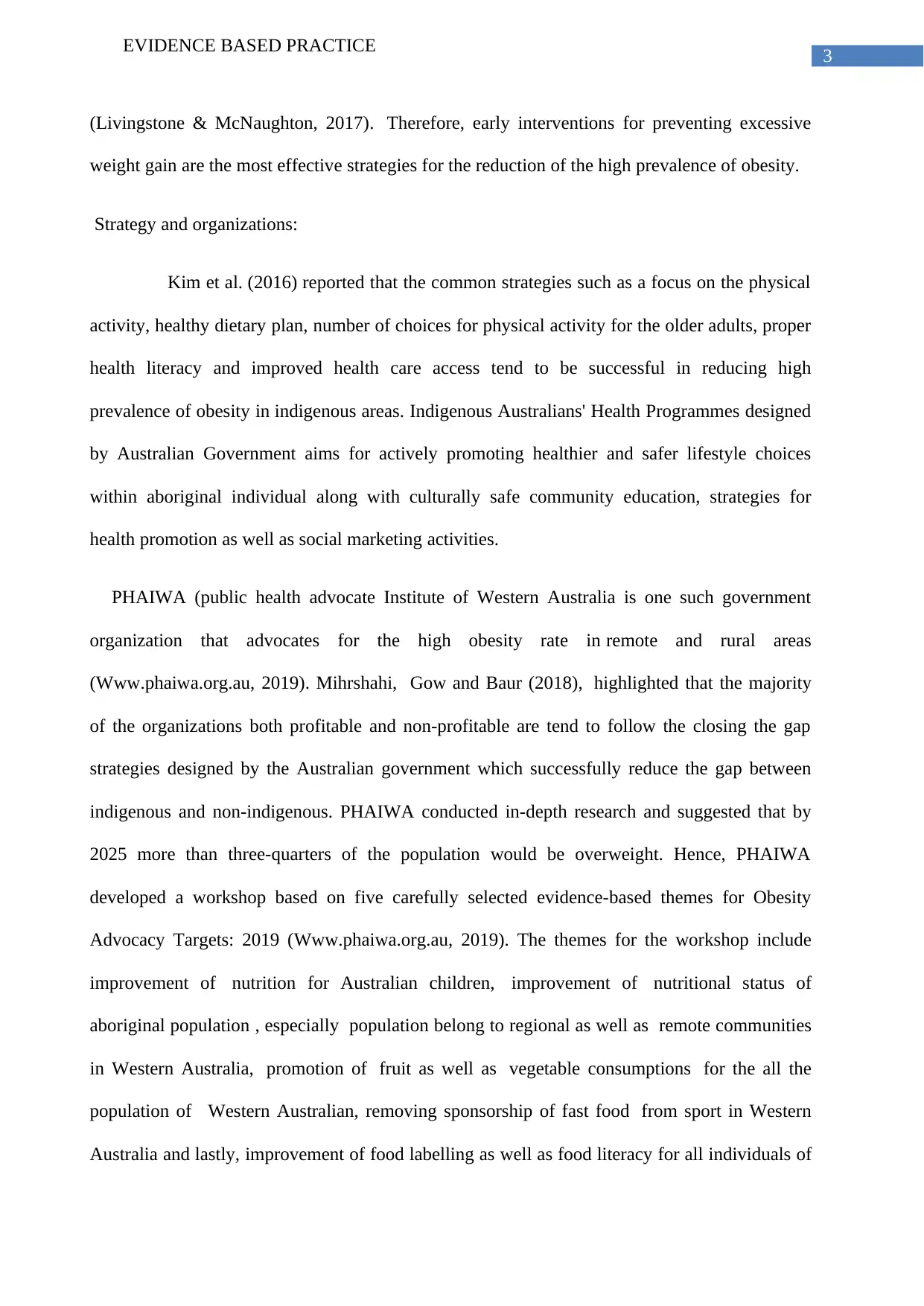
3
EVIDENCE BASED PRACTICE
(Livingstone & McNaughton, 2017). Therefore, early interventions for preventing excessive
weight gain are the most effective strategies for the reduction of the high prevalence of obesity.
Strategy and organizations:
Kim et al. (2016) reported that the common strategies such as a focus on the physical
activity, healthy dietary plan, number of choices for physical activity for the older adults, proper
health literacy and improved health care access tend to be successful in reducing high
prevalence of obesity in indigenous areas. Indigenous Australians' Health Programmes designed
by Australian Government aims for actively promoting healthier and safer lifestyle choices
within aboriginal individual along with culturally safe community education, strategies for
health promotion as well as social marketing activities.
PHAIWA (public health advocate Institute of Western Australia is one such government
organization that advocates for the high obesity rate in remote and rural areas
(Www.phaiwa.org.au, 2019). Mihrshahi, Gow and Baur (2018), highlighted that the majority
of the organizations both profitable and non-profitable are tend to follow the closing the gap
strategies designed by the Australian government which successfully reduce the gap between
indigenous and non-indigenous. PHAIWA conducted in-depth research and suggested that by
2025 more than three-quarters of the population would be overweight. Hence, PHAIWA
developed a workshop based on five carefully selected evidence-based themes for Obesity
Advocacy Targets: 2019 (Www.phaiwa.org.au, 2019). The themes for the workshop include
improvement of nutrition for Australian children, improvement of nutritional status of
aboriginal population , especially population belong to regional as well as remote communities
in Western Australia, promotion of fruit as well as vegetable consumptions for the all the
population of Western Australian, removing sponsorship of fast food from sport in Western
Australia and lastly, improvement of food labelling as well as food literacy for all individuals of
EVIDENCE BASED PRACTICE
(Livingstone & McNaughton, 2017). Therefore, early interventions for preventing excessive
weight gain are the most effective strategies for the reduction of the high prevalence of obesity.
Strategy and organizations:
Kim et al. (2016) reported that the common strategies such as a focus on the physical
activity, healthy dietary plan, number of choices for physical activity for the older adults, proper
health literacy and improved health care access tend to be successful in reducing high
prevalence of obesity in indigenous areas. Indigenous Australians' Health Programmes designed
by Australian Government aims for actively promoting healthier and safer lifestyle choices
within aboriginal individual along with culturally safe community education, strategies for
health promotion as well as social marketing activities.
PHAIWA (public health advocate Institute of Western Australia is one such government
organization that advocates for the high obesity rate in remote and rural areas
(Www.phaiwa.org.au, 2019). Mihrshahi, Gow and Baur (2018), highlighted that the majority
of the organizations both profitable and non-profitable are tend to follow the closing the gap
strategies designed by the Australian government which successfully reduce the gap between
indigenous and non-indigenous. PHAIWA conducted in-depth research and suggested that by
2025 more than three-quarters of the population would be overweight. Hence, PHAIWA
developed a workshop based on five carefully selected evidence-based themes for Obesity
Advocacy Targets: 2019 (Www.phaiwa.org.au, 2019). The themes for the workshop include
improvement of nutrition for Australian children, improvement of nutritional status of
aboriginal population , especially population belong to regional as well as remote communities
in Western Australia, promotion of fruit as well as vegetable consumptions for the all the
population of Western Australian, removing sponsorship of fast food from sport in Western
Australia and lastly, improvement of food labelling as well as food literacy for all individuals of
Secure Best Marks with AI Grader
Need help grading? Try our AI Grader for instant feedback on your assignments.

4
EVIDENCE BASED PRACTICE
Western Australian (Www.phaiwa.org.au, 2019). The organizations invited key stakeholders for
facilitating discussions of each theme.
Conclusion:
Thus it can be concluded that obesity has emerged as a major risk for chronic diseases such
as cardiovascular disease, type 2 diabetes and some of the musculoskeletal diseases around the
globe. The literature highlighted that obesity is particularly common amongst the Aboriginal
Australian, compared to non-indigenous Australians where socio-demographic factors have
emerged as the leading cause of obesity. Hence, common strategies such as a focus on physical
activity, healthy dietary plan, and improved health care access tend to be successful in reducing
the high prevalence of obesity in indigenous areas. PHAIWA is one such organization that
supports the wellbeing of the indigenous population.
EVIDENCE BASED PRACTICE
Western Australian (Www.phaiwa.org.au, 2019). The organizations invited key stakeholders for
facilitating discussions of each theme.
Conclusion:
Thus it can be concluded that obesity has emerged as a major risk for chronic diseases such
as cardiovascular disease, type 2 diabetes and some of the musculoskeletal diseases around the
globe. The literature highlighted that obesity is particularly common amongst the Aboriginal
Australian, compared to non-indigenous Australians where socio-demographic factors have
emerged as the leading cause of obesity. Hence, common strategies such as a focus on physical
activity, healthy dietary plan, and improved health care access tend to be successful in reducing
the high prevalence of obesity in indigenous areas. PHAIWA is one such organization that
supports the wellbeing of the indigenous population.
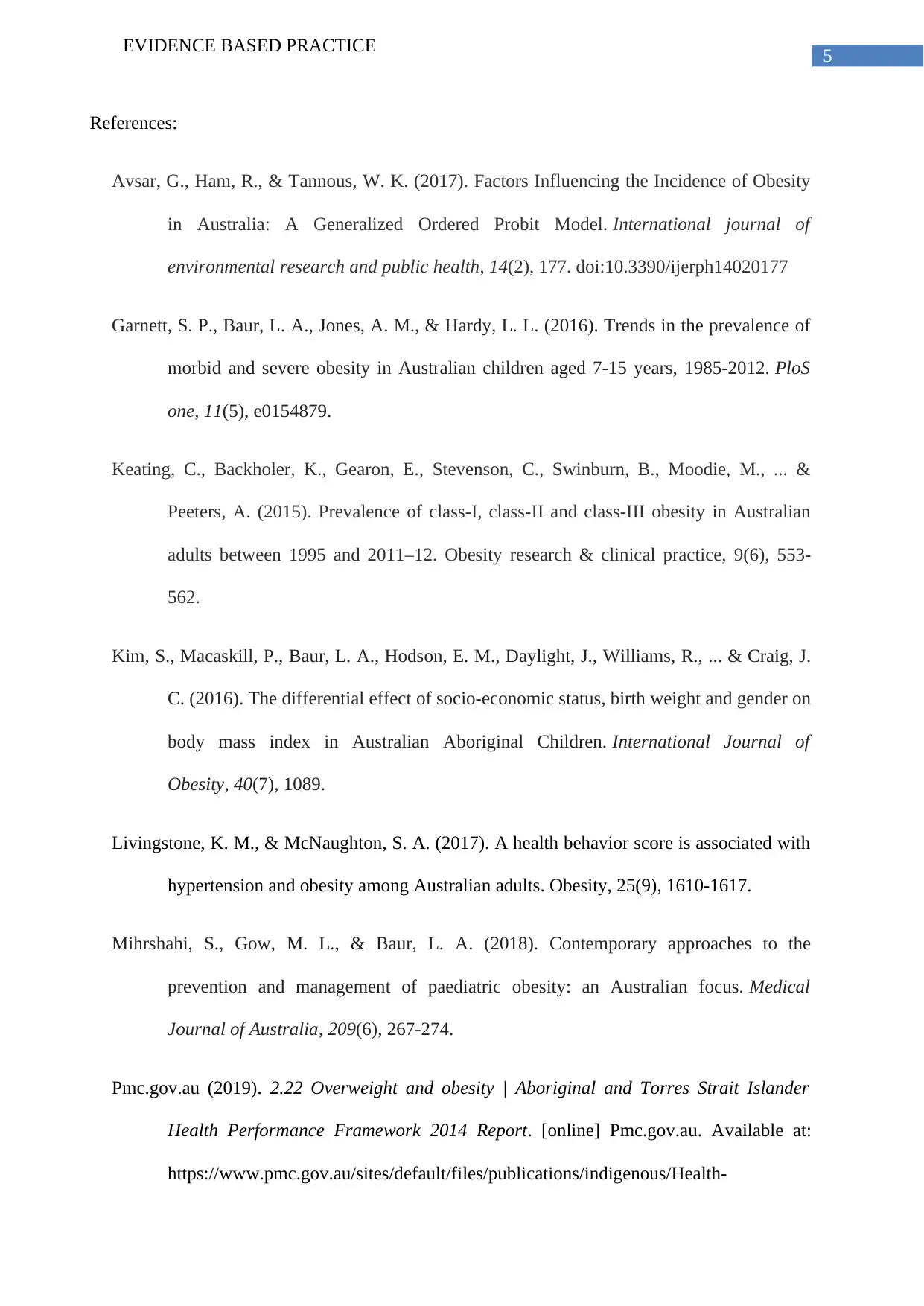
5
EVIDENCE BASED PRACTICE
References:
Avsar, G., Ham, R., & Tannous, W. K. (2017). Factors Influencing the Incidence of Obesity
in Australia: A Generalized Ordered Probit Model. International journal of
environmental research and public health, 14(2), 177. doi:10.3390/ijerph14020177
Garnett, S. P., Baur, L. A., Jones, A. M., & Hardy, L. L. (2016). Trends in the prevalence of
morbid and severe obesity in Australian children aged 7-15 years, 1985-2012. PloS
one, 11(5), e0154879.
Keating, C., Backholer, K., Gearon, E., Stevenson, C., Swinburn, B., Moodie, M., ... &
Peeters, A. (2015). Prevalence of class-I, class-II and class-III obesity in Australian
adults between 1995 and 2011–12. Obesity research & clinical practice, 9(6), 553-
562.
Kim, S., Macaskill, P., Baur, L. A., Hodson, E. M., Daylight, J., Williams, R., ... & Craig, J.
C. (2016). The differential effect of socio-economic status, birth weight and gender on
body mass index in Australian Aboriginal Children. International Journal of
Obesity, 40(7), 1089.
Livingstone, K. M., & McNaughton, S. A. (2017). A health behavior score is associated with
hypertension and obesity among Australian adults. Obesity, 25(9), 1610-1617.
Mihrshahi, S., Gow, M. L., & Baur, L. A. (2018). Contemporary approaches to the
prevention and management of paediatric obesity: an Australian focus. Medical
Journal of Australia, 209(6), 267-274.
Pmc.gov.au (2019). 2.22 Overweight and obesity | Aboriginal and Torres Strait Islander
Health Performance Framework 2014 Report. [online] Pmc.gov.au. Available at:
https://www.pmc.gov.au/sites/default/files/publications/indigenous/Health-
EVIDENCE BASED PRACTICE
References:
Avsar, G., Ham, R., & Tannous, W. K. (2017). Factors Influencing the Incidence of Obesity
in Australia: A Generalized Ordered Probit Model. International journal of
environmental research and public health, 14(2), 177. doi:10.3390/ijerph14020177
Garnett, S. P., Baur, L. A., Jones, A. M., & Hardy, L. L. (2016). Trends in the prevalence of
morbid and severe obesity in Australian children aged 7-15 years, 1985-2012. PloS
one, 11(5), e0154879.
Keating, C., Backholer, K., Gearon, E., Stevenson, C., Swinburn, B., Moodie, M., ... &
Peeters, A. (2015). Prevalence of class-I, class-II and class-III obesity in Australian
adults between 1995 and 2011–12. Obesity research & clinical practice, 9(6), 553-
562.
Kim, S., Macaskill, P., Baur, L. A., Hodson, E. M., Daylight, J., Williams, R., ... & Craig, J.
C. (2016). The differential effect of socio-economic status, birth weight and gender on
body mass index in Australian Aboriginal Children. International Journal of
Obesity, 40(7), 1089.
Livingstone, K. M., & McNaughton, S. A. (2017). A health behavior score is associated with
hypertension and obesity among Australian adults. Obesity, 25(9), 1610-1617.
Mihrshahi, S., Gow, M. L., & Baur, L. A. (2018). Contemporary approaches to the
prevention and management of paediatric obesity: an Australian focus. Medical
Journal of Australia, 209(6), 267-274.
Pmc.gov.au (2019). 2.22 Overweight and obesity | Aboriginal and Torres Strait Islander
Health Performance Framework 2014 Report. [online] Pmc.gov.au. Available at:
https://www.pmc.gov.au/sites/default/files/publications/indigenous/Health-
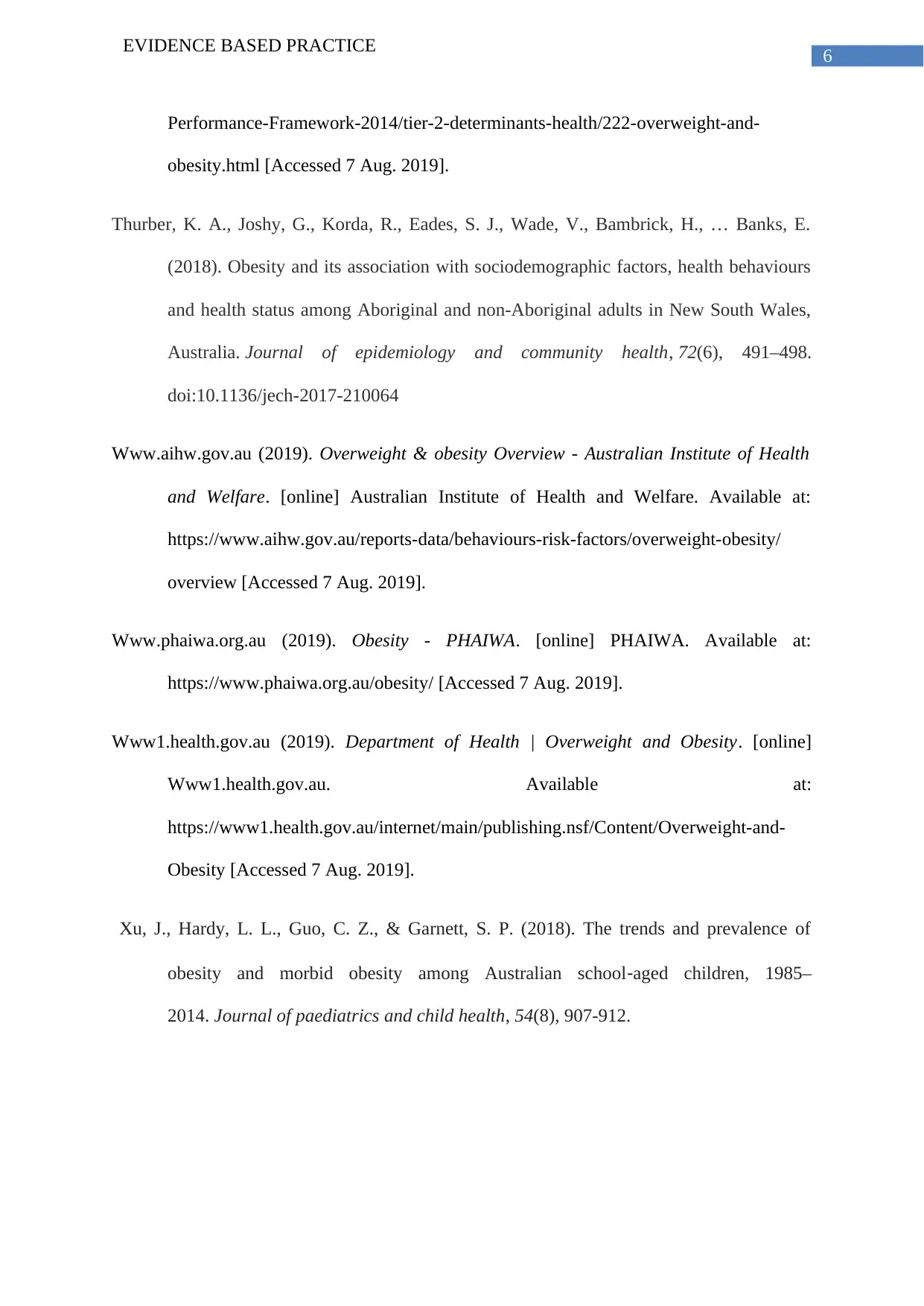
6
EVIDENCE BASED PRACTICE
Performance-Framework-2014/tier-2-determinants-health/222-overweight-and-
obesity.html [Accessed 7 Aug. 2019].
Thurber, K. A., Joshy, G., Korda, R., Eades, S. J., Wade, V., Bambrick, H., … Banks, E.
(2018). Obesity and its association with sociodemographic factors, health behaviours
and health status among Aboriginal and non-Aboriginal adults in New South Wales,
Australia. Journal of epidemiology and community health, 72(6), 491–498.
doi:10.1136/jech-2017-210064
Www.aihw.gov.au (2019). Overweight & obesity Overview - Australian Institute of Health
and Welfare. [online] Australian Institute of Health and Welfare. Available at:
https://www.aihw.gov.au/reports-data/behaviours-risk-factors/overweight-obesity/
overview [Accessed 7 Aug. 2019].
Www.phaiwa.org.au (2019). Obesity - PHAIWA. [online] PHAIWA. Available at:
https://www.phaiwa.org.au/obesity/ [Accessed 7 Aug. 2019].
Www1.health.gov.au (2019). Department of Health | Overweight and Obesity. [online]
Www1.health.gov.au. Available at:
https://www1.health.gov.au/internet/main/publishing.nsf/Content/Overweight-and-
Obesity [Accessed 7 Aug. 2019].
Xu, J., Hardy, L. L., Guo, C. Z., & Garnett, S. P. (2018). The trends and prevalence of
obesity and morbid obesity among Australian school‐aged children, 1985–
2014. Journal of paediatrics and child health, 54(8), 907-912.
EVIDENCE BASED PRACTICE
Performance-Framework-2014/tier-2-determinants-health/222-overweight-and-
obesity.html [Accessed 7 Aug. 2019].
Thurber, K. A., Joshy, G., Korda, R., Eades, S. J., Wade, V., Bambrick, H., … Banks, E.
(2018). Obesity and its association with sociodemographic factors, health behaviours
and health status among Aboriginal and non-Aboriginal adults in New South Wales,
Australia. Journal of epidemiology and community health, 72(6), 491–498.
doi:10.1136/jech-2017-210064
Www.aihw.gov.au (2019). Overweight & obesity Overview - Australian Institute of Health
and Welfare. [online] Australian Institute of Health and Welfare. Available at:
https://www.aihw.gov.au/reports-data/behaviours-risk-factors/overweight-obesity/
overview [Accessed 7 Aug. 2019].
Www.phaiwa.org.au (2019). Obesity - PHAIWA. [online] PHAIWA. Available at:
https://www.phaiwa.org.au/obesity/ [Accessed 7 Aug. 2019].
Www1.health.gov.au (2019). Department of Health | Overweight and Obesity. [online]
Www1.health.gov.au. Available at:
https://www1.health.gov.au/internet/main/publishing.nsf/Content/Overweight-and-
Obesity [Accessed 7 Aug. 2019].
Xu, J., Hardy, L. L., Guo, C. Z., & Garnett, S. P. (2018). The trends and prevalence of
obesity and morbid obesity among Australian school‐aged children, 1985–
2014. Journal of paediatrics and child health, 54(8), 907-912.
1 out of 7
Related Documents
Your All-in-One AI-Powered Toolkit for Academic Success.
+13062052269
info@desklib.com
Available 24*7 on WhatsApp / Email
![[object Object]](/_next/static/media/star-bottom.7253800d.svg)
Unlock your academic potential
© 2024 | Zucol Services PVT LTD | All rights reserved.





